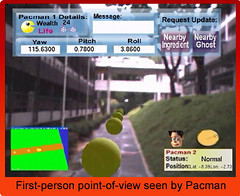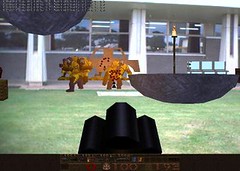On Art and The Desire To Murder
I'm beginning to formulate a new theory about art and artists (this might have something to do with the last couple of episodes of Gallery Watch I've been slogging through) and it goes something like this:
The more interesting their body of work, the less interesting they are as interview subjects.
It's as if their creative drive is all focused on what they do rather than who they are. They're not neccessarily better artists, or better at being artists; they are incredibly insightful and talented - they just haven't figured out how to speak in soundbites.
So that was my long weekend: cutting the mad Hungarian's funky camerawork, breaking in the new presenter (who, being French Canadian, has the cutest accent), and slicing together a comprehensible show out of 40 minutes' rambling conversation. Nice artwork, though.

But after a long weekend hours of mind-numbing tedium, all I've wanted to do is shoot things. So what do I discover? AR Quake (that's Augmented Reality Quake - halfway between VR Quake and gunning people down for real), and Human Pacman which was of course funded by the military.
With that sort of money behind it, it's hardly surprising there's such an increasingly sophisticated subculture of games developement designed around real-time interactive combat and strategy.

AR Quake
But it's not all frag-or-be-fragged, there're also non-violent games like CatchBob and A Force More Powerful, which simulates organising protest demonstrations. That's right, it's a strategy game about civil disobedience for politically conscious gamers, the sort of gamer who would probably be opposed to Kuma/War, for example.
I don't know which planet this is, but I think I love being on it.




No comments:
Post a Comment